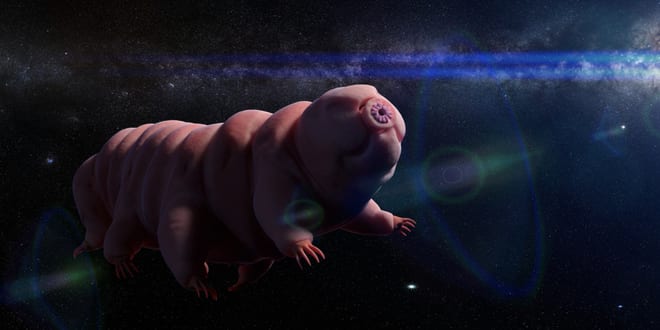The Israeli spacecraft Beresheet may be living up to its name in an unexpected manner; by bringing life in the form of the nearly indestructible animals called Tardigrades, also known as ‘water bears’ or ‘moss piglets’ to the moon.
The Beresheet lunar lander was a glorious effort that nearly succeeded. After eight years and $95 million, it failed in its final moments when a gyroscopic failure sent it crashing into the moon’s surface at over 300 mph on April 11.
The mission was thought to be a complete loss.
But scientists announced this week that there may have been survivors; moss piglets, a micro-animal, in a cryptobiotic (dehydrated) state.
The moss piglets were placed aboard the lunar lander by the Arch Mission Foundation (AMF). Nova Spivack and Nick Slavin founded AMF in 2015 with the goal of creating multiple redundant repositories of human knowledge around the Solar System. Toward this end, AMF built a special “Lunar Library” payload for Beresheet containing a DVD-sized archive constructed of 25 thin sheets of nickel and containing a staggering 30 million pages of information. Almost as an afterthought, Spivak added a thin layer of epoxy resin between each layer containing human DNA samples and, stuck to a piece of tape, several thousand dehydrated tardigrades.
Tardigrades are water-dwelling eight-legged segmented micro-animals (about .5 millimeters long).
They are commonly known as water-bears. They are among the most resilient animals known, found almost everywhere even in the most extreme environments. Able to survive exposure to extreme temperatures, extreme pressures (both high and low), air deprivation, radiation, dehydration, and starvation. Tardigrades have survived all five mass extinction events that have occurred in the earth’s history.
Moss Piglets are one of the few groups of species that are capable of suspending their metabolism.
They can also go without food or water for more than 30 years, only to later rehydrate, forage, and reproduce. In 2007, a NASA experiment determined that Tardigrades were the first known animal to survive in outer space. After being dehydrated, a batch of tardigrades was launched into low-earth orbit. For ten days, they were exposed to the hard vacuum of outer space and solar radiation. After being rehydrated back on Earth, over 68 percent of the subjects revived within 30 minutes following rehydration and were able to reproduce. Scientists have revived tardigrades after as much as ten years in this dehydrated state
It was for their incredible durability that they were chosen by the Arch Mission Foundation to be passengers aboard the Israeli moon mission.
In an interview with Wired, Spivack announced that an assessment by his team of experts concluded that the library could have survived the crash intact. And the tardigrades as well. “Ironically, our payload may be the only surviving thing from that mission,” Spivack told Wired.
Spivack assured the public that there is no reason to worry about tardigrades taking over the moon.
In order to survive, the tardigrades from Beresheet must be rehydrated in someplace with an atmosphere. The possibility of space missions infecting other planets is a real concern and is the purview of NASA’s Office of Planetary Protection. Missions destined for places like Mars where life can survive and may already exist are subject to stringent sterilization processes. Missions to the moon are not since they consider the possibility of survival or infection minimal or non-existent. As a result of this policy, Apollo missions have left several hundred bags of human feces on the lunar surface.
Even the hardy little moss piglets would not be able to survive on the moon but the possibility of life traveling from one planet to another, referred to as panspermia, has been the focus of much speculation. Panspermia is the hypothesis that life exists throughout the Universe, distributed by meteoroids or, as in the case of the tardigrades on the moon, by spacecraft. Proponents of the theory suggest that surviving organisms could become active and begin to colonize their new environment. Evidence to support the theory has been found on meteoroids and is considered a valid possibility by many scientists. Panspermia does not conjecture about the origin of life, only on how it may be spread throughout the universe.
It is interesting to note that the lowly tardigrade was the subject of sci-fi panspermia.
A 2017 segment of the Netflix produced series “Star Trek: Discovery” featured a larger-than-life sentient tardigrade character as an essential element to the interstellar spore-drive. Like its micro-origins, the Federation tardigrade was virtually indestructible and could enter a cryptobiotic state. Star Trek recognized the tardigrade’s formidable nature and had it kill dozens of Klingons. In the end, the tardigrade was released into space to wander the cosmos.
So, even though the lunar tardigrades are a clear case of actual man-made panspermia, there is little chance outside of science fiction that the tardigrades from Beresheet could rehydrate and reproduce. Unless, of course, the crash sent them flying in the directions of the bags of astronaut poo.




